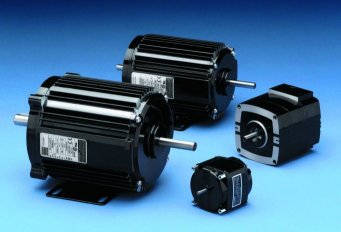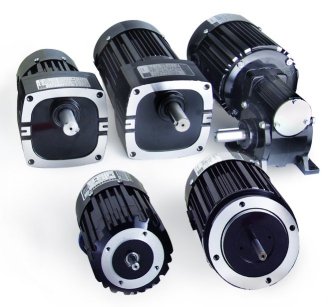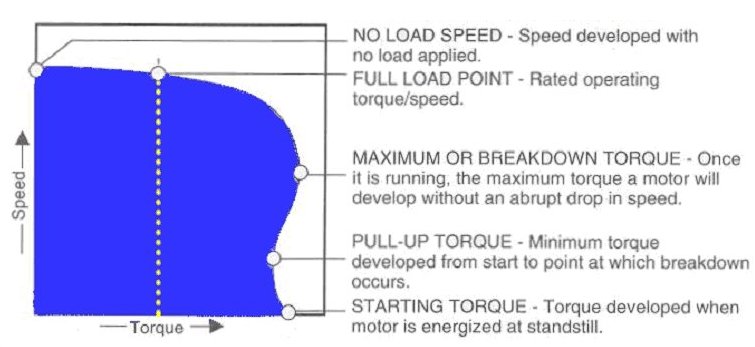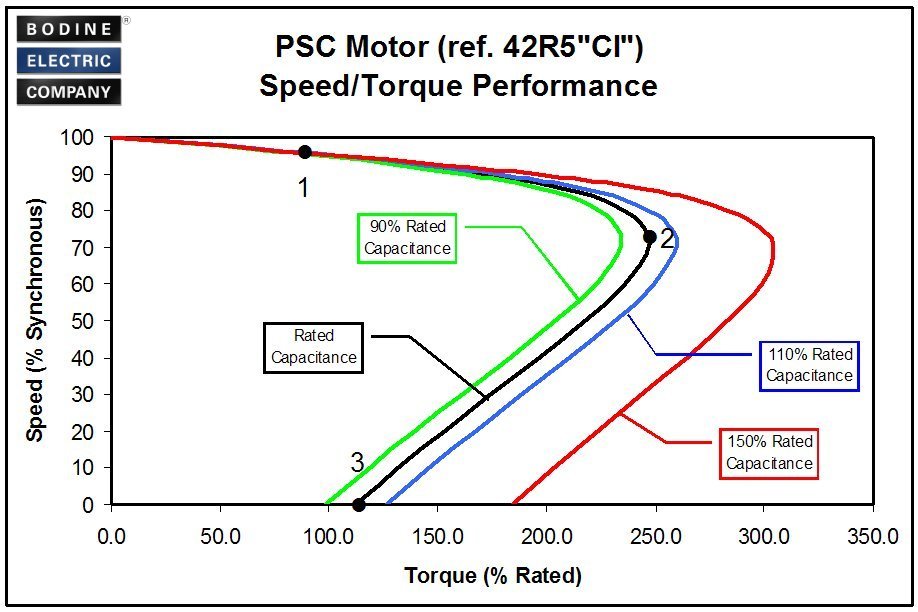You can get higher starting torque from an AC induction motor by replacing factory specified capacitors with larger ones. But pushing the motor too far beyond design specs is risky. Here’s how capacitance affects motor performance.
Capacitors for permanent-split-capacitor (PSC) and capacitor-start (CS) AC induction motors are sized by motor manufacturers to produce adequate starting torque for most fractional-horsepower (FHP) applications. To increase starting torque, users sometimes replace factory-installed capacitors with larger ones. But tampering with recommended capacitances could adversely affect some important motor parameters such as starting current and running efficiency. If these parameters get too far out of line with motor-design specifications, windings overheat and ultimately burn out. Here’s how PSC and CS motors operate, and how changes in capacitance affect motor performance.
Capacitor Start Motors
The CS motor is essentially a split-phase motor with a capacitor for starting (see our catalog S-16, page 43, or the Bodine Handbook for additional info). The motor has two windings: a main or run winding, and an auxiliary or start winding. The start winding is used only for starting the motor. The run winding is energized for starting and running. Because of the capacitor is in the start winding, currents in the two windings are out-of-phase. This out-of-phase relationship sets up a rotating magnetic field that starts the rotor turning. When the motor accelerates to approximately 70% of its normal operating speed, the start winding and capacitor circuit are disconnected by a speed-sensitive centrifugal switch, a current-sensing relay, or other means.
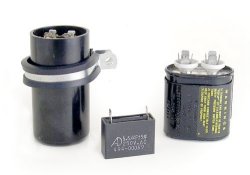
Motor Capacitors for Fractional Horsepower Motors and Gearmotors (left to right: Electrolytic, Film-, Oil-Type)
The capacitor value has no effect on the running performance of the CS motor. However, starting torque and current both increase with capacitance. Motor manufacturers select capacitor values to meet the starting torque requirements of typical applications without exceeding the current capabilities of the motor and its circuits. Typical CS motors have capacitors that produce maximum starting torques of about four times the full-load running torque. If more starting torque is required and if the motor circuit can safely provide additional current, some users replace the manufacturer’s standard-rated capacitor with one of greater capacitance. However, this is usually done at the expense of other parameters. And if the capacitance increase is excessive, starting torque may actually be reduced.
For a typical 1/15 hp CS motor, a capacitor with double the capacitance of the rated capacitor will only increase starting torque 50%, and starting current is almost doubled. For some circuits, this increase in starting current may be unacceptable. Other equipment such as lights on the same branch circuit with large motors may be affected by possible line-voltage drop. Also, the life and reliability of the winding and centrifugal switch or starting relay in the motor is reduced by increased current.
Because the capacitor is connected only while starting, its duty cycle is highly intermittent. Thus, the capacitor can be an inexpensive and relatively small AC electrolytic or metalized film type. A normal, non-polarized, AC electrolytic capacitor consists of two aluminum plates separated by a porous paper which is saturated with an electrolyte. Because these capacitors are not designed for continuous duty, the maximum on-time should not exceed 3 seconds and the maximum number of 3-second starts should generally not exceed 20 per hour (metalized film type capacitors are available for continuous duty operation). However, most applications start in less than 3 seconds so that the number of starts can be increased in proportion to the decrease in starting time. For example, a typical 0.5-second start permits the motor to be started 120 times per hour.
If the number of starts is too frequent or too long, windings and capacitors will overheat and motor reliability will decrease. In such cases, a Permanent-Split-Capacitor motor should be used. Also, PSC motors are more suitable for applications where frequent reversing is required, since the CS motor is reversible only from its rest position because of the starting switch.
Permanent-Split-Capacitor Motors
A Permanent-Split-Capacitor motor is similar to a CS motor and also contains two windings: a main winding and a capacitor winding. In a PSC motor, however, the capacitor winding is permanently connected in series with an AC oil-type or metallized film capacitor. Unlike the CS motor, the auxiliary winding and capacitor are energized during both starting and running. Thus, continuous-duty ac oil-type or metalized film capacitors are installed in PSC motors. The dielectric in the capacitor is an oil-impregnated paper or plastic film as opposed to the aluminum oxide in ac electrolytic capacitors. The oil-type capacitor is inherently larger and more costly than the metallized film or electrolytic type.
The PSC motor operates similarly to a two-phase motor and is, therefore, inherently more quiet and efficient than a CS motor. However, the phase angle in a PSC motor changes with load so that the motor usually is less efficient during starting than during running. In usual motor design, a compromise is made between the two operating points. Changing the capacitor value as specified by the manufacturer will affect both running and starting characteristics so that any improvements in starting usually decrease running performance. For example, a 200% increase in capacitance in a typical 1/15-hp motor approximately doubles the starting torque. However, the running efficiency of the motor drops from approximately 50% to 18%, and serious overheating of the motor results. Many motors are designed to operate close to the thermal limit of their insulation class rating. An increase in capacitance can increase the winding temperature rise above the allowed limit.
Some PSC motors use a second capacitor for starting purposes only. This second capacitor may be an electrolytic or metallized film type. This version is called a two-capacitor motor or a two-capacitor-start, one-capacitor-run motor. Two capacitors preserve the efficiency and quietness of the PSC motor when running while improving the starting characteristics. By using one capacitor for running and another in parallel for starting, starting torque can be increased without impairing running performance. An analysis of the PSC speed-torque curve reveals that where acceleration is important, it would be wise not to use too large a capacitance for starting purposes. In fact, even though the starting torque may be the same for two values of capacitance, the average accelerating torque may be less for the larger capacitance.
Supporting Images and Charts:
1) How to read a Speed-Torque Curve (Bodine Handbook, page 7-25)
2) Bodine Type 42R5”CI” AC Motor Example with various Capacitors
1 – Rated Speed and torque (approx. 98 oz-in at 1700 RPM, 4-pole) 2 – Breakdown Torque 3 – Starting Torque
Comments to above graph:
A) Changing the factory specified capacitor to a different than rated value will void the product warranty, may affect motor performance, and/or can lead to product failure.
B) The above graph is an example only! The gains shown may or may not apply to any Bodine AC, PSC stock windings. Motor heating, insulation class limits, and current draw must be reviewed on a case-by-case basis!
-
the synchronous speed of a 4-pole AC motor at 60Hz is 1800 RPM
-
this particular winding example has slightly more starting torque than running torque
-
effects from capacitor change vary from frame to frame, and winding to winding
-
increased capacitance (>100%) will increase current draw and power consumption
-
the motor’s duty cycle will have to be reduced if capacitance is chosen too high
-
increased current draw from a larger capacitor might cause fuses or breakers to go off/trip
-
capacitor changes will affect the motor’s power factor/phase angle, which in turn, will affect current draw, power and heat…
Click here, to download a PDF version of this article.
By Edmund Glueck. Copyright Bodine Electric Company © 01/2010. All rights reserved.
